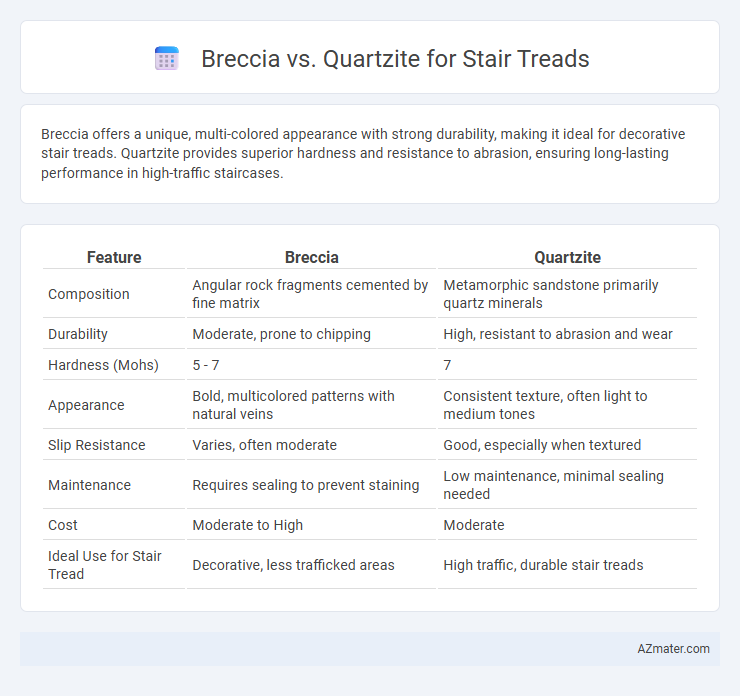Breccia offers a unique, multi-colored appearance with strong durability, making it ideal for decorative stair treads. Quartzite provides superior hardness and resistance to abrasion, ensuring long-lasting performance in high-traffic staircases.
Table of Comparison
| Feature | Breccia | Quartzite |
|---|---|---|
| Composition | Angular rock fragments cemented by fine matrix | Metamorphic sandstone primarily quartz minerals |
| Durability | Moderate, prone to chipping | High, resistant to abrasion and wear |
| Hardness (Mohs) | 5 - 7 | 7 |
| Appearance | Bold, multicolored patterns with natural veins | Consistent texture, often light to medium tones |
| Slip Resistance | Varies, often moderate | Good, especially when textured |
| Maintenance | Requires sealing to prevent staining | Low maintenance, minimal sealing needed |
| Cost | Moderate to High | Moderate |
| Ideal Use for Stair Tread | Decorative, less trafficked areas | High traffic, durable stair treads |
Introduction to Breccia and Quartzite Stair Treads
Breccia and quartzite are two popular natural stone choices for stair treads, prized for their unique textures and durability. Breccia features angular fragments cemented together, offering a dramatic, mosaic-like appearance ideal for luxury or statement staircases. Quartzite, a metamorphic rock composed mostly of quartz, is renowned for its hardness and resistance to wear, making it a practical option for high-traffic stair treads with a sleek, natural look.
Geological Origins: Breccia vs Quartzite
Breccia forms from angular rock fragments cemented together by mineral matrix, originating in sedimentary or volcanic environments with rapid deposition and tectonic activity. Quartzite is a metamorphic rock generated through the recrystallization of sandstone under intense heat and pressure, resulting in a dense, interlocking crystal structure. The distinct geological origins influence durability and aesthetic qualities critical for stair tread applications.
Aesthetic Differences: Colors and Patterns
Breccia features bold, angular fragments in various earthy tones such as browns, reds, and grays, creating a dramatic, mosaic-like pattern ideal for statement stair treads. Quartzite exhibits a more uniform, subtle grain with a softer palette ranging from whites and light grays to soft blues, offering a sleek, contemporary aesthetic. The contrast in colors and patterns makes Breccia better suited for dynamic visual impact, while Quartzite provides a refined, elegant look for stair treads.
Durability and Strength Comparison
Breccia and quartzite differ significantly in durability and strength for stair tread applications, with quartzite offering superior hardness and resistance to wear due to its high quartz content. Breccia, composed of cemented fragments with varying mineral composition, tends to be less dense and more prone to abrasion under heavy foot traffic compared to quartzite's consistent crystalline structure. The Mohs hardness of quartzite typically ranges from 7 to 8, making it ideal for stair treads that demand long-lasting strength and minimal maintenance.
Slip Resistance and Surface Texture
Breccia offers a rougher surface texture with angular fragments that enhance slip resistance, making it suitable for stair treads in areas prone to moisture. Quartzite typically features a smoother, denser surface with higher hardness but may require additional treatments or finishes to improve traction. Choosing Breccia ensures better natural grip, while Quartzite demands careful surface preparation to meet slip resistance standards for safe stair tread applications.
Maintenance Requirements for Each Stone
Breccia stair treads require regular sealing due to their porous nature, which helps prevent stains and moisture penetration, while quartzite demands less frequent sealing because of its dense, non-porous structure that offers superior resistance to water and scratches. Cleaning breccia involves gentle, pH-neutral cleaners to avoid etching, whereas quartzite can tolerate mild detergents and is easier to maintain with routine sweeping and mopping. Both stones benefit from prompt spill cleanup, but quartzite's robust durability reduces the frequency of necessary restorative maintenance compared to the more delicate breccia.
Weather Resistance and Outdoor Suitability
Breccia exhibits excellent weather resistance due to its composition of angular fragments cemented together, making it highly durable for outdoor stair treads exposed to varying climates. Quartzite, a metamorphic rock formed from sandstone, offers superior hardness and resistance to abrasion, ensuring longevity in harsh weather conditions. Both materials are suitable for outdoor use, but quartzite's denser structure provides enhanced protection against moisture and freeze-thaw cycles.
Installation Considerations: Breccia vs Quartzite
Breccia requires careful sealing and maintenance due to its porous nature and varied composition, making installation more sensitive to moisture and staining risks. Quartzite offers superior hardness and durability, allowing for easier handling during installation and better resistance to chipping or surface damage on stair treads. Proper substrate preparation is essential for both stones, but quartzite's dimensional stability reduces the likelihood of shifting or cracking under foot traffic.
Cost Analysis and Budget Considerations
Breccia stair treads typically range from $70 to $150 per square foot due to their unique, fragmented appearance and limited supply, making them a higher-cost option compared to quartzite. Quartzite stair treads, priced between $50 and $120 per square foot, offer a durable and budget-friendly alternative with high resistance to wear and natural stone aesthetics. Budget considerations should include installation expenses, where quartzite often requires less specialized labor, reducing overall project costs compared to the more intricate handling of breccia.
Which Stone is Best for Your Stair Treads?
Breccia offers a unique, striking appearance with its angular fragments cemented together, providing excellent durability and resistance to wear, making it suitable for stair treads in both residential and commercial spaces. Quartzite is a natural metamorphic rock known for its exceptional hardness and scratch resistance, ensuring long-lasting performance and a sleek, consistent surface ideal for high-traffic staircases. Choosing between Breccia and Quartzite depends on aesthetic preference and durability needs, with Quartzite favored for maximum hardness and Breccia preferred for its distinctive, bold patterns.

Infographic: Breccia vs Quartzite for Stair Tread
 azmater.com
azmater.com